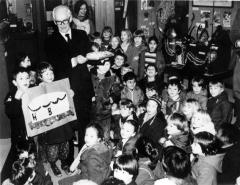
Bryan Cranstone receiving a 100th birthday card and cake on behalf of the Museum from the children of a local school 1998.267.26
The Pitt Rivers Museum has two boxes of manuscript material from Cranstone. These principally concern his lectures and proposed publication on Technology which seems to have been a lifetime interest.
Many of Cranstone’s notes for his lectures when he was teaching are now held by the PRM manuscript collections. For example, the illustrations on this page are taken from his notes for the course on the ‘Technology of Simple Societies’. Copies of these notes were distributed to the students. One of his students recalls that 'his lectures were inspirational - more like a combination of small group tutorials and handling sessions. Packed full of information and possibilities'. [Alison Roberts, pers. comm.] It is clear that the lectures began with an oversight of what made particular technologies develop. The second illustration shows the development of particular forms, in this case boomerangs and clubs (this image is closely aligned to Pitt Rivers' own work on boomerang technology, see here for more information about that). The third illustration is from a section titled ‘Hafting’ and is much more specific about particular technologies and ways of achieving something. Another series is called Tools.
At the time of first European contacts Oceania and North America still depended on stone technology for cutting tools. In central and South America there was a developed technology in gold, silver, copper, etc but not in iron. Iron was used in Europe, Asia and Africa. … Without simple tools (especially wood-working tools) other tools and weapons cannot be made, land cannot be cleared for agriculture, wood cannot be cut for making houses, boats, traps etc.
He then discusses particular forms of tools eg cutting tools, abrasive tools, scrapers, borers etc. It seems that he covered a topic a week (an Oxford term lasts 8 full weeks). He also discussed fire-making, containers [discussing their materials and uses], simple machines eg wedges and levers, agricultural technology eg hoes and picks etc. From one of the entries it is clear that Cranstone had first established this series of lectures at University College, London when he gave a course entitled, 'Primitive Technology'.
When Bryan Cranstone retired in September 1985 his post as Curator was taken by Schuyler Jones:
Mr Cranstone's energy, enterprise, and devotion to the needs of the museum are greatly appreciated and will be long remembered. Much has been accomplished during his years as Curator. Everyone is pleased that he will be staying in Oxford and grateful that he has consented to continue teaching in the department for the time being. [Museum Annual Report 1985-6]
In an article in 1965 Cranstone gave a preliminary report about his fieldwork among the Telefomin. It is clear that his interest in material culture and technology informed the choice of items for the British Museum Ethnographical Expedition to New Guinea 1963-4 to concentrate on:
The aims of the Expedition
The principal object of the expedition was the formation of a collection to illustrate as completely as possible the material culture of a mountain people whose way of life had not yet been substantially modified by Western influence. The collection was to be supplemented by the fullest documentation possible concerning subsistence and manufacturing techniques, raw materials, sources of supply, associated beliefs and practices and in fact all aspects of the life of the people closely connected with their material culture and technology. [Cranstone, 1965: 111-112]
Between 1974 and 1979 Cranstone discussed with Paul Elek Ltd publishing a book about technology, between 1979-1981 he discussed it with Granada Publishing Ltd
The outline of the book appears to have been:
Introduction
Tools, machines and weapons
Subsistence: Hunting, fishing and collecting
Subsistsence: Agriculture and Livestock
Food drink and stimulants
Dwelling and other Structures
Manufacturing techniques: Animal and vegetable fibres
Manufacturing techniques: Pottery and metal working
Transport by land and water
This was clearly based on his lecture series. A full summary of the chapter contents is given in the correspondence, much of the contents appears to have been written, presumably not published.
Some of Cranstone's publications about technology:
Cranstone, B.A.L. 1951. '83. Stone Age Man's Use of Power' Man, Vol. 51, (Apr., 1951), pp. 48-50 [Based on a talk he read to Section H of the British Association for the Advancement of Science, 1950 as an opening contribution to a discussion on 'Man's Use of Energy']
Cranstone, B.A.L. 1957. A Malay 'Umbrella' The British Museum Quarterly, Vol. 21, No. 2 (Jul., 1957), pp. 57-58
Cranstone, B.A.L. 1965. 'The British Museum Ethnographical Expedition to New Guinea, 1963-4: A Preliminary Report' The British Museum Quarterly, Vol. 29, No. 3/4 (Summer, 1965), pp. 109-118
Cranstone, B.A.L. 1967. 'Some boards from a New Guinea Haus Tambaran' Man, New Series, Vol. 2, No. 2 (Jun., 1967), pp. 274-277
Cranstone, B.A.L. 1968. 'War shields of the Telefomin Sub-district, New Guinea' Man, New Series, Vol. 3, No. 4 (Dec., 1968), pp. 609-624
Cranstone, B.A.L. 1971. 'The Tifalmin: A 'Neolithic' people in New Guinea World Archaeology, Vol. 3, No. 2, Archaeology and Ethnography (Oct., 1971), pp. 132-142